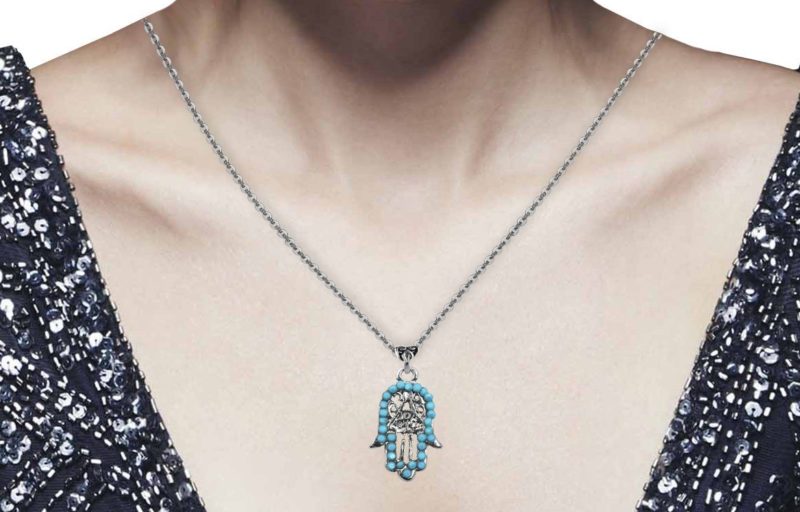
Amulets and charms have different effects on the aura of the wearer. The strength of a magical item is influenced by its origin and original value in culture and confessional cults. However, it happens that amulets of the same shape are found in different cultures and religions. One of these symbols is Hamsa or, in other words, the Hand of Fatima.
The origin of the amulet

Anchovy - an amulet in the form of a palm with a symmetrically located little finger and thumb. Another name for this magic symbol is the Hand of Fatima. There is no reliable information about the occurrence of this ancient amulet. According to one version, this symbol is associated with a beautiful Islamic legend about the daughter of the Great Prophet Mohammed - Fatima.
According to legend, Fatima loyally and selflessly loved her husband - the valiant Ali. The woman did not want to share her husband with anyone, but he did not heed her requests. Once, when Fatima was preparing a favorite treat of Ali - halva, the husband brought his second wife to the house.
This shocked poor Fatima so much that she not only didn’t notice how she dropped the spoon, which halva was stirring, but also, without feeling physical pain due to the grief pouring over her, she began to stir the hot treat with her right hand. Shocked by Ali, he was so imbued with Fatima’s grief that he immediately abandoned his desire to marry another woman. In memory of what happened, Ali created an amulet in the form of an open palm - the Hand of Fatima.
The meaning of the hamsa amulet

According to the classical Muslim interpretation, the Hand of Fatima symbolizes the Five Main Virtues of man:
- Prayer coming from the heart;
- Faith not defiled by doubt;
- Mecca - pilgrimage to the sacred place;
- Fasting, cleansing the body and soul;
- Mercy manifested in piety.
Also, the symbol of Hamsa means conjugal devotion, a woman's selfless love for her husband. Fatima's hand protects against:
- Cheating or death of a spouse;
- Total lack of money and poverty;
- The “Black Strip” in life and a series of misfortunes;
- Doubts about the power and mercy of God;
- Loss of patience and self-control in a critical situation;
- Quarrel with relatives and close friends.
In addition, the Hamsa amulet is used by travelers as a guarding amulet. The hand of Fatima helps in the process of cognition and study by a person of new disciplines.
What does the Hand of Fatima mean in different cultures?

As mentioned above, the Hamsa amulet is found not only in Muslim, but also in other world cultures. The meanings of this symbol in different cultures vary significantly, although there are certain similarities in interpretation:
- In Christianity open palm symbol is called "The right hand of God." In the center of the hand is a cross. For Christians, such an amulet has a spiritual healing function. According to legends, the one who wears the Hand of God on his chest will more easily find the right path in life;
- In Judaism — "Hand of Miriam", in the center of the open palm is the six-pointed Star of David. The interpretation of the symbol is in many ways similar to the Muslim, but deeper.The Hand of Miriam, one of the sacred symbols of the Jewish Pentateuch, serves as a reminder of the duty of each creature to the Creator. The amulet protects the body and soul of the black witchcraft and ancestral curse;
- In Hinduism - it is from this interpretation that the name came Anchovy, meaning the sounds of breathing during meditation. Ham - a strong and sharp breath, Sa - a long and calm exhale. In the center of the hand - the mantra "Om" ( "AUM"), or fish eyes. The value of the symbol - a peaceful life and warmth, protection from violence and death threats.
We should also mention the meaning of the symbols in the center of the hand:
- Mantra "Ohm" - cleansing of chakras from black energy;
- Red or blue eye - health promotion and development of the sixth sense;
- Fish - luck and prosperity;
- Star of David or Arabic script - storage of the hearth;
- Cross - protection of the carrier from demons and demons.
The amulet “Fatima's Hand” is worn in the form of a charm bracelet detail or as a separate pendant. Needless decoration is most often made of non-ferrous metals: silver, gold or copper. To know about the meaning of the symbol to wear it - not necessarily. Hamsa is one of the most loyal amulets that does not harm those who unknowingly wear it.
Hamsa Amulet Tattoo

Another interpretation of the amulet with the open palm - Indian. North American Indians applied the appropriate symbol on their body in the form of a tattoo. In the center of the hand was always depicted a wide open eye, which symbolized the omnipresence of the Gods and Ancestors. The presence of a representative of the Indian tribe like tattoos spoke of his psychic abilities.
To develop your clairvoyance abilities, get a tattoo in the shape of a Hamsa amulet on your shoulders or around the back of your head. It is best if the image is on a blue or green background.
Nowadays, the interpretation of the symbol of an open palm depends on which image is in the center of the hand (Star of David, cross, eye, mantra, etc.). Common tattoos Hands Miriam are the following functions:
- Protecting a person from negative magical effects;
- Protection for travelers and natural adventurers;
- For the fair sex - to ensure a successful marriage and a happy married life.
Most often, the Hamsa symbol is applied to the back. It is believed that in this way you can protect yourself from betrayal.
Who should use the amulet?

The hand of Fatima is a universal symbol. Therefore, anyone can wear it, regardless of religion, ethnicity and worldview. The main condition for this amulet - sincerity and positive attitude of the owner.
Hamsa does not like deceit and deceit. This amulet can even harm such people.
As a talisman symbol Hand of Miriam, select the following categories of people:
- Travelers
- Creative personalities
- Young women (especially expectant mothers);
- Newlyweds;
- Believers, regardless of religion;
- Children as a talisman against damage and the evil eye.
The listed social groups of Hamsa will always bring good luck and confidence in the future.
Amulet Activation

To activate the amulet, you will need the help of the four elements. Prepare for the procedure:
- Glass of water;
- A handful of earth;
- Lighted incense stick (symbol of Fire and Air).
Aromatic sticks smoldering over Hamsa amulet spend several times. In this case, inhale the smell of incense spreading in the air. Then sprinkle Hand Fatima ground, whereupon water bathe symbol. Read the plot:
I open my palm -
But not for the negative.
I’ll sprinkle the earth with good and justice,
Wash the face of the universe with honesty and truth
Gusts of wind breaking from my lips
Fire breaking out of my heart
And there will be a palm open to me with help and a charm,
May it be so!
After reading the plot, you can immediately put on the amulet - it is activated. From now on, your aura is under powerful energy protection.
How to make your own hands?

As in the case of any other amulet, the most powerful will be the amulet that you create yourself. To do this, you do not need to smel out from metal a complex symbol of an open palm. You can buy the appropriate pendant.
For independent manufacture of the amulet, you will need a pendant in the form of the Hand of Fatima and a natural red thread. Put the thread with the symbol attached to it on the left wrist of the person you love, tie it to 7 knots. Read the plot:
The first knot is from evil and sorrow.
The second node is from fear and horror.
The third, fourth - from the walk of the dead.
Fifth, sixth - the pain is big.
I knit the last knot -
I order to be happy.
Amulet, amulet,
Protect [name of the person being spoken] - from troubles!
No sooner said than done - but in a century will not change!
It’s important to consider that you cannot tie a thread with the symbol of the Hand of God to yourself. Ask for this simple rite of a family member or close friend. Best of all, if one of your closest relatives activates the amulet - mother, father, sister, brother or spouse. Family ties will make the amulet stronger.


































